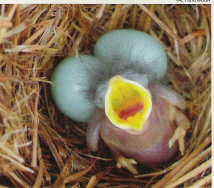 | greenville business & community directory |
|
This is an archived page that may contain outdated or incorrect information. Please visit www.Greenville.com for the latest news, events, and more.
 You can grow your own Birdhouse gourds, and it is so much fun! They make a beautiful addition to any sunny garden spot. The best part is reaping the harvest-- no two are alike! Let them dry through the winter, and by the next spring, you can make your own birdhouse!
You can grow your own Birdhouse gourds, and it is so much fun! They make a beautiful addition to any sunny garden spot. The best part is reaping the harvest-- no two are alike! Let them dry through the winter, and by the next spring, you can make your own birdhouse!
Growing Birdhouse gourds, also known as Bottle or Langenaria gourds, is a great project for kids. The best part is reaping the harvest-- no two are alike! Let them dry through the winter, and by the next spring, you can make your own birdhouse. No matter where you live, gourds require two things: a sunny spot and plenty of room. Choose the sunniest place you have with a good southern exposure. Gourds grow on vines and vines love to roam. It's best to keep the vines cut back to ten feet lengths and let them crawl up some type of support structure. Any type of structure will work as long as it is very sturdy. Gourds are very heavy when they are growing. Some excellent structures are trellises, arbors, fences, stonewalls, rope strung between two poles, arches of chicken wire, and even dead trees. Gourds can be grown on the ground, and if they are very heavy should be; but they are more prone to insects and disease as well as blemishes and flattened sides. You will get the best Birdhouse gourds if you provide a good support structure for them. In South Carolina, growing gourds is simple. Just plant the seeds outdoors after the last frost in a sunny spot in mounds 10 feet apart, provide a support structure, and put of shovel full of well-rotted manure beneath the planting surface. They do not need to be fertilized after this. More fertilizer just means more vine growth and fewer gourds. It usually takes a few weeks before the vines began to grow, but once they start, you will be amazed at how fast they do. Make sure you give them plenty of water. Watering them in the morning is best. Try not to get the foliage wet as it encourages mildew and invites insects. Cutting the vines when they reach ten feet lengths will encourage more female flowers to develop which means a larger yield of gourds. White funnel-shaped flowers will appear first on the ends of the vines. These are male flowers. White funnel-shaped flowers with a small bulb shape below them will appear about two weeks later on the lateral vines; these are female flowers. Female flowers are only open for about 24 hours. They open early in the morning or in the late evening. You can sit back and let nature take its course at this point. Or, you can help things along by hand pollinating the female flowers. Hand pollinating is easy and usually ensures a larger gourd crop. When the female flower opens, pinch off the male flower and gently rub the stamen against the pistil of the female flower. Try to rub as much pollen as you can on the pistil. If you'd like to save seeds for next year, tie squares of cheesecloth around a male flower and a female flower before they open making sure they are completely covered. When they both are open, remove the cheesecloth and hand pollinate as above. Cover the female flower with cheesecloth again and tie a string marker on the vine below the flower. The flower will dry and fall off the vine leaving a gourd that will have true seeds that you can save and plant next year. As the gourds form and begin to grow, make sure that you water them heavily. The growing gourds will be green and turn yellowish as they mature. It is best to keep them off the ground. This way they will keep their rounded shape. If they are on the ground, putting a mound of hay underneath them will help. You can create interesting shapes and patterns on young gourds by tying string or bands of fabric around the gourd. If you place the forming gourds in containers such as jars or boxes made out of hard materials like heavy plastic, wood, or glass, the gourds will form into that shape. Four to six weeks before the first frost, stop watering the gourd vines. This begins the hardening off period. Some growers prefer to leave their gourds on the vine until spring to dry; others prefer to remove them from the vine before the first frost, although Birdhouse gourds are very hardy and pretty frost resistant. If you're not sure which method to use, try them both. If you remove them from the vine, be very careful. They will bruise easily which will result in blemishes on the hardened shell. Carefully wipe them with rubbing alcohol or vinegar and water. Lay them out on several layers of newspaper or a wooden palette in a dry, well-ventilated area. Make sure they do not touch each other. Turn them daily until the skin hardens and compost any that appear shriveled. The outer skin will begin to harden into a wood-like shell in about a week. Let them continue drying for at least four weeks more. They may take months to dry completely. You can tell they are dry when they feel very light and the seeds rate when you shake them. Once they are dry, wash them with steel wool or a scouring pad and a mild soap solution. They are now ready to make into birdhouses! Making a birdhouse from a gourd is a fun project. And, it's so easy! Birds love gourd houses and feeders. They are truly built from nature and one of a kind, since no two gourds are alike, and you add your own style.
The Supplies
The Fun Part 2. Use a drill to make the holes. Drill two 1/8 inch holes in the top for the hanger and four more in the bottom for drainage. Use a drill or an Exacto saw to make the birdhouse opening: it should be 1-1/4 to 1-1/2 inches in diameter. 3. Remove cover from gourd hole and pull out the inside seeds and matter. 4. Push the wire through the two holes at the top. Twist the ends together to form a loop through the hole. Pull the loop around to hide the twisted part inside the top of the gourd. 5. Bend the wire flat at the tip of the loop. Push the flattened part through the two beads, thus stringing the beads onto the folded wire. 6. Open the wire loop above the beads and insert a pencil in the opening. While holding the beads in place, twist the wire with the pencil until it is twisted tight and twisted all the way through the beads. 7. If you want, decorate your gourd by drawing designs on it with waterproof pens, painting with acrylic paints, or you can leave it plain. 8. We recommend that you put a polyurethane finish on the outside of the gourd. Though gourds are durable and able to withstand the elements as they are, they will eventually break down. The polyurethane will help them last longer. 9. Using the cup hook, install your gourd birdhouse on the north side of your house, under the eaves. The gourd birdfeeder may be used anywhere in your yard. (Images and story provided by the South Carolina Wildlife Commission,)
|

 metal scrub pad
metal scrub pad